#BIENNALE ARCHITETTURA 2021
Text

Nordic Pavilion for the Venice Biennale, by Sverre Fehn (1962). In background the exhibition "What We Share. A model for cohousing".
Biennale Architettura 2021 / Venice, Italy.
© Roberto Conte (2021)
54 notes
·
View notes
Text
Lesley Lokko - the 2024 RIBA Royal Gold Medal Recipient
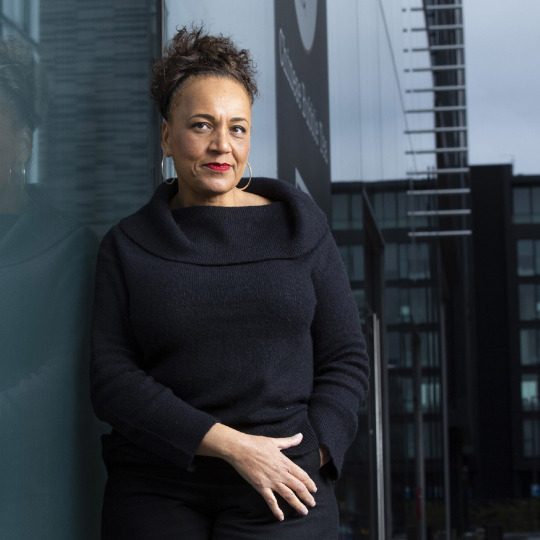
© Murdo McLeod. Image Courtesy of La Biennale Architettura 2021
Professor Lesley Lokko OBE is a renowned Ghanaian-Scottish architect, educator, and best-selling novelist. She is the Founder and Director of the African Futures Institute (AFI) in Accra, Ghana, which is an independent postgraduate school of architecture and public events platform. In December 2021, she was appointed as the Curator of the 18th International Architecture Exhibition, La Biennale di Venezia. In December 2022, she was awarded an OBE in the first New Year's Honors List by King Charles III, for her exceptional contributions to architecture and education. As an author, she has published 13 bestsellers.
She is the recipient of the 2020 RIBA Annie Spink Award and currently serves as a Visiting Professor at The Bartlett School of Architecture, UCL, and a Visiting Full Professor at the School of Architecture, Planning and Environmental Policy, University College Dublin. She is also a Trustee of the London-based Architecture Foundation and a Founding Member of the Council on Urban Initiatives, co-founded by LSE Cities, UN-Habitat, and UCL Institute for Innovation and Public Purpose.
On the 18th of January 2024, the Royal Institute of British Architects announced that Professor Lesley Lokko had become the first African female to receive the prestigious Royal Gold Medal, which was established in 1848. She joins the ranks of Zaha Hadid and Yasmeen Lari, as the only women to have been awarded the medal since its inception.
“I hope that this award will also make it clear that the divisions that we inherit, that we construct, that we put upon ourselves between different aspects of our lives not that they don't matter but perhaps they're not the first place that we should be looking when we're thinking about change and about moving forward. So, I very much hope that this medal demonstrates that it's worth it to think differently. It’s worth it to go off piste or to go off the beaten track”. - Prof. Lesley
We at the AFA network hope that her final submission in the announcement video will inspire you on your path towards architecture.
Article written by Otie Pokua Yankyera on 23 January 2024.
0 notes
Text
Carlo Ratti named curator of 2025 Venice Biennale Architecure Exhibition
New Post has been published on https://thedigitalinsider.com/carlo-ratti-named-curator-of-2025-venice-biennale-architecure-exhibition/
Carlo Ratti named curator of 2025 Venice Biennale Architecure Exhibition


MIT scholar Carlo Ratti has been named curator of the Venice Biennale’s 19th International Architecture Exhibition, to be held in 2025.
The large-scale exhibition is the world’s best-known showcase for architectural work. It began in 1980 and has normally been held every two years since then.
Ratti is an expert in urban design and planning, who has conducted many innovative studies of city dynamics using mobile sensors and other technologies, revealing insights that can be applied to the built environment on many scales. At the same time, Ratti is an active designer whose work has been displayed previously at the Venice Biennale, along with New York City’s Museum of Modern Art, the Design Museum in Barcelona, and the Museum of Science in London, among other venues.
Currently, Ratti is professor of the practice of urban technologies and planning within MIT’s Department of Urban Studies and Planning.
“We architects like to think we are smart, but real intelligence is everywhere,” Ratti said in a statement released by the Biennale. “The disembodied ingenuity of evolution, the growing power of computers, and the collective wisdom of the crowd. To face a burning world, architecture must harness all the intelligence around us. I am honored and humbled to have the opportunity to curate the Biennale Architettura 2025.”
AT MIT, Ratti also serves as director of the Senseable City Lab, which he founded. In addition to his studies and design projects, Ratti has authored multiple books, including “The Atlas of the Senseable City” (2023), co-authored with Antoine Picon of Harvard University, and “The City of Tomorrow: Sensors, Networks, Hackers, and the Future of Urban Life” (2016), co-authored with Matthew Claudel.
Ratti is a founding partner of the architecture and innovation office CRA-Carlo Ratti Associati, which has office in Turin, New York City, and London. He graduated from the Politecnico di Torino, and the École Nationale des Ponts et Chaussées in Paris. He conducted his MPhil and PhD work at the University of Cambridge, and completed his PhD thesis as a Fulbright Scholar at MIT.
Ratti is the second person from MIT selected as curator of the architecture Biennale in recent years. Hashim Sarkis, dean of MIT’s School of Architecture and Planning, served as curator for the Biennale in 2021 — which was originally scheduled to run in 2020, but got delayed for one year due to the Covid-19 pandemic.
MIT artists have also been well represented at the Venice Biennale’s International Art Exhibition, which also runs every two years. The MIT List Visual Arts Center has presented three exhibitions at the Biennale, featuring Joan Jonas, Fred Wilson, and Ann Hamilton.
The 19th International Architecture Exhibition will run from May 24 through Nov. 23, 2025.
#2023#architecture#Art#artists#Arts#Books#Collective#computers#covid#Design#dynamics#Environment#Evolution#Faculty#Future#Global#hackers#Innovation#insights#intelligence#it#life#list#List Visual Arts Center#mit#Mobile#museum#networks#new york#new york city
0 notes
Text
Milano: Gli appuntamenti di maggio per il centenario di Triennale Milano

Milano: Gli appuntamenti di maggio per il centenario di Triennale Milano.
A maggio ricorre il centenario di Triennale Milano che, dopo l’apertura del Museo del Design Italiano il 15 aprile, verrà festeggiato attraverso una serie di iniziative che si svolgeranno nel corso delle prossime settimane.
Il 19 maggio 1923 alla Villa Reale di Monza veniva inaugurata la Biennale delle arti decorative, prima edizione di quella che successivamente (nel 1930) diventerà un’Esposizione Internazionale con cadenza triennale e che nel 1933 si trasferirà a Milano, nel Palazzo dell’Arte, appositamente costruito da Giovanni Muzio.
Stefano Boeri, Presidente di Triennale Milano afferma: “In cento anni di storia Triennale Milano ha interrogato i grandi cambiamenti socio-culturali e ha saputo anticipare progettualità e tendenze; è stata un forum in cui le idee visionarie di designer, architetti, artisti, pensatori di tutto il mondo hanno trovato uno spazio di confronto aperto e libero. Questo centenario per noi ha senso come ripartenza. Triennale vuole avere un profilo preciso, innovativo e internazionale: quello di una scuola in cui fare ricerca e dare risposta, attraverso i linguaggi e le discipline della cultura contemporanea, a quella domanda di futuro che caratterizza il nostro difficile presente.”
Il centenario entrerà nel suo vivo con l’installazione performativa Senza Titolo di Romeo Castellucci, Grand Invité di Triennale Milano per il quadriennio 2021-2024, che verrà presentata dal 2 al 7 maggio. Un progetto appositamente commissionato per l’anniversario dell’istituzione che vedrà lo spazio del Salone d’Onore trasformato in un immenso limbo immacolato, dimora per i performer e per il loro gesto reiterato, come un rito primordiale che parte dai corpi per diventare danza e infine ancestrale preghiera.
L’11 maggio è in programma la festa Triennale 100 Sweet Years, aperta a tutta la città, che inaugura la programmazione di Triennale Estate, manifestazione che da maggio a settembre fa vivere il Giardino di Triennale con talk, concerti, performance e che quest’anno giunge alla sua quarta edizione.
Il 12 maggio apre al pubblico la mostra Home Sweet Home, a cura di Nina Bassoli (fino al 10 settembre). L’esposizione indaga le trasformazioni della casa e l'evoluzione dell'idea di abitare attraverso i lavori dedicati a questo tema in un secolo di mostre ed Esposizioni Internazionali di Triennale. I temi dei progetti espositivi del passato vengono riletti in una prospettiva contemporanea, rivoluzionando le contrapposizioni tra casa e lavoro, maschile e femminile, produzione e riproduzione, spazio pubblico e spazio privato. La narrazione storica si intreccia a dieci ambienti totali site-specific affidati a progettisti contemporanei, delle vere e proprie mostre nella mostra, tra cui i londinesi Assemble Studio, la paesaggista francese Céline Baumann, la designer Matilde Cassani, il Canadian Centre for Architecture (CCA), lo studio statunitense vincitore del Pritzker Prize 2019 Diller Scofidio + Renfro, lo studio di architettura DOGMA, l’architetta Maria Giuseppina Grasso Cannizzo, il duo Lacaton & Vassal, Pritzker Prize 2021, lo studio catalano MAIO, il collettivo Sex and the City.
Il 19 maggio, in occasione del giorno dell’inaugurazione della Biennale delle arti decorative, è in programma un convegno che si terrà a Monza alla Villa Reale sulla nascita dell’ISIA – Istituto Superiore per le Industrie Artistiche, avvenuta proprio durante la prima edizione della Biennale delle arti decorative. Un appuntamento che nasce dal dialogo e la collaborazione con il Consorzio della Villa Reale di Monza.
I progetti per il centenario di Triennale continueranno nel corso del resto dell’anno, in particolare con la mostra sulla pittura italiana contemporanea (a cura di Damiano Gullì, ottobre 2023 – gennaio 2024), che riprende la tradizione della pittura murale delle Esposizioni Internazionali storiche e offre un excursus sulla produzione pittorica di oltre 100 artisti attivi in Italia dagli anni Novanta a oggi, e con l’apertura a dicembre degli archivi di Triennale, che permetteranno di valorizzare e condividere con il pubblico un vasto patrimonio, fino a oggi archiviato e conservato all’interno del Palazzo dell’Arte....
#notizie #news #breakingnews #cronaca #politica #eventi #sport #moda
Read the full article
0 notes
Text
How we will live together?

Werden wir eines Tages umsiedeln und die Erde zurücklassen?
(Biennale Architettura 2021, Venedig)
1 note
·
View note
Text

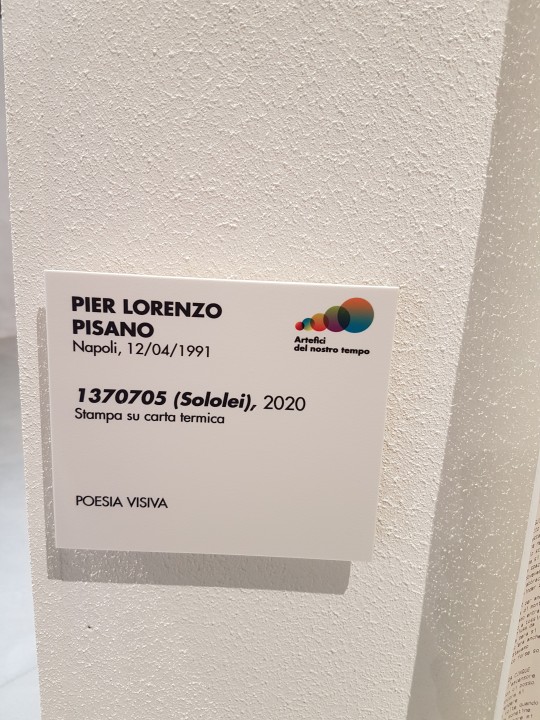





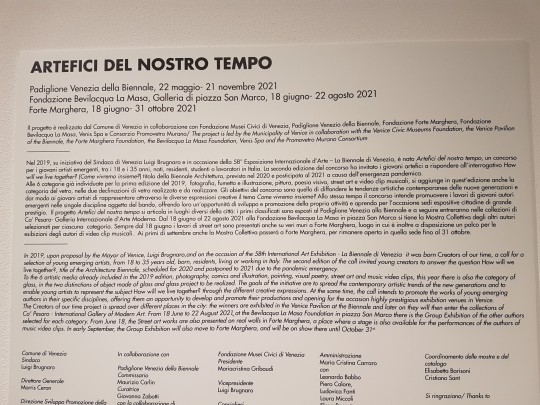
Biennale, Venice Pavillion - How we will live together?
#biennale di venezia#Biennale#Biennale Architettura 2021#Venice#How we will live together?#Venezia#contemporary art#Naples#Neapolitan Artist#contest#young artists#giovani artisti#arte italiana
20 notes
·
View notes
Photo

VENEZIA
BIENNALE ARCHITETTURA 2021
SKIRTING THE CENTER: SVETLANA KANA RADEVIĆ ON THE PERIPHERY OF POSTWAR ARCHITECTURE – BIENNALE ARCHITETTURA 2021 EVENTI COLLATERALI
1 note
·
View note
Text
Regresa la Bienal de Arquitectura de Venecia - 17° Edición
Regresa la Bienal de Arquitectura de Venecia – 17° Edición
VENICE, 22.05 – 21.11 2021 / BIENNALE ARCHITETTURA 2021HOW WILL WE LIVE TOGETHER?
La edición número 17 de la Bienal de Arquitectura de Venecia, que se celebrará del 22 de mayo al 21 de noviembre y que contará con la participación de más de 40 países, abrirá al público luego de un año de aplazamiento por la COVID-19. Centrada en el tema de cómo convivir en un mundo de desigualdades, la exposición…

View On WordPress
#17 Edición#2021#22.05 - 21.11 2021#Arquitectos#Arquitectura#Bienal de Venecia#BIENNALE ARCHITETTURA 2021#HOW WILL WE LIVE TOGETHER?#Venice
0 notes
Photo
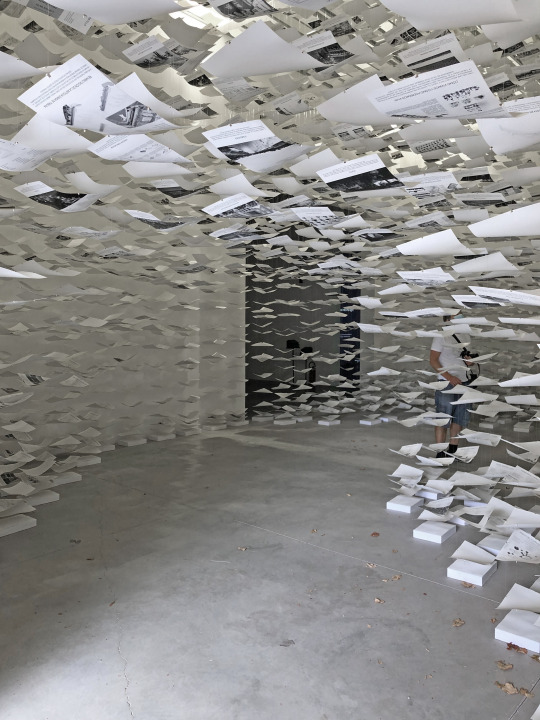

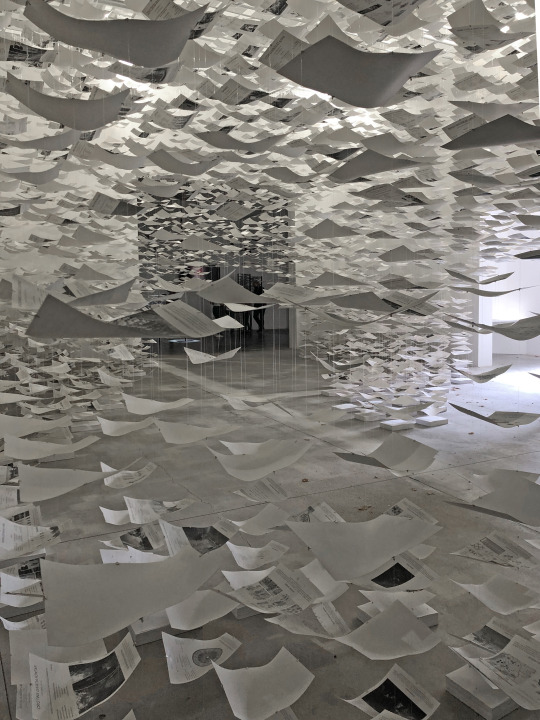
‘ UNCERTAINTY’ - SPANISH PAVILION
BIENNALE ARCHITETTURA 2021
Venice, Italy
Image © Juliaknz
#architecture#exhibition#spanish#spain#biennale#venice#design#art#artwork#frame#uncertainty#juliaknz#theclassyissue#archdaily#dezeen#ignant#thisispaper#material#form#minimalism#europe#biennale architettura#photograph
283 notes
·
View notes
Text
Milano: La presentazione del volume “Rossella Gilli. Il Potere degli Elementi” a Palazzo Reale
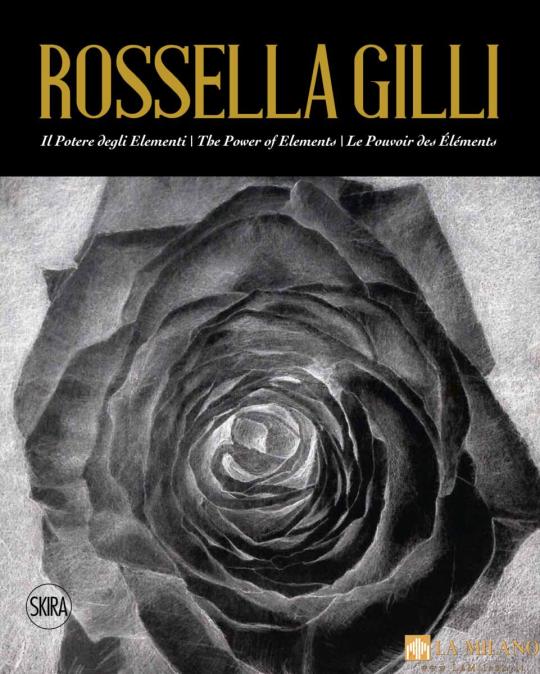
Milano: La presentazione del volume “Rossella Gilli. Il Potere degli Elementi” a Palazzo Reale.
Lunedì 6 marzo, nella Sala Conferenze di Palazzo Reale a Milano ci sarà la presentazione del volume “Rossella Gilli. Il potere degli Elementi”, edito da Skira a cura di Fortunato D’Amico. All’interno dell’importante monografia, in tre lingue, sono presenti testi di Fortunato D’Amico fra cui un’esaustiva intervista che si sofferma sui punti salienti del lavoro di Rossella Gilli.
L’evento coinvolgerà come relatori Domenico Piraina, direttore di Palazzo Reale, Fortunato D’Amico, curatore del volume e l’artista Rossella Gilli.
Il libro traccia una dettagliata panoramica del percorso artistico di Rossella Gilli, dall'inizio della sua carriera fino alle ultime opere realizzate. Analizza con precisione le evoluzioni del suo fare arte e la continua ricerca attraverso tecniche e materiali differenti. Le opere di Gilli sono molto variegate e ricche di simbolismi, trovando espressione su tele, sculture, incisioni e gioielli.
La sua arte è influenzata dai grandi maestri dell'arte come Caravaggio, Leonardo, Tiziano, Degas, Turner e Casorati, così come dai celebri scultori come Medardo Rosso. L'attenzione al disegno, alla resa dei volumi, alla luce e al colore emerge in modo evidente nelle tele con soggetti architettonici, naturalistici e nei nudi. Inoltre, l'aspetto spirituale è spesso legato ai 5 elementi della filosofia cinese: metallo, legno, acqua, fuoco e terra.
L'artista definisce le sue opere "alchemiche", poiché mostrano quanto sia labile il confine tra realtà concreta e astratta. La sua poetica mette in evidenza una continua rielaborazione e reinterpretazione dei segni e dei simboli, che determina un cambiamento esteriore connesso alle dinamiche e ai moti interiori dell'animo. Questo percorso avviene in maniera indipendente, senza un iter prestabilito, ma richiede una particolare sensibilità e conduce a riconoscere lo spostamento dei saperi oltre la provvisorietà della materia.
Le ottanta immagini delle opere sono raggruppate in macro-temi, come Nudi e Ritratti, Mare, Terra Sabbia Roccia, Architettura, Sculture, Fiori, Gioielli. Ognuno di essi mostra la messa a punto del processo alchemico, ovvero la trasformazione di soggetti reali in rappresentazioni allegoriche. Le immagini dell'acqua, delle sabbie, delle rocce, delle pietre e delle architetture lasciano intravedere letture differenti che danno vita a molteplici interpretazioni.
Il fiore è il simbolo alchemico più adatto a rappresentare Rossella Gilli, spesso raffigurato dall'artista. In esso sono nascosti i misteri della vita svelati attraverso l'analisi attenta della forma e della perfetta geometria.
Rossella Gilli è un'artista milanese laureata in Storia dell'Arte presso l'Università di Milano e ha conseguito un dottorato di ricerca presso l'Università di Firenze. La sua ricerca artistica si concentra sul disegno, che l'ha portata ad aprire una galleria a Milano dedicata alle incisioni e ai disegni antichi, frequentata da importanti personalità del mondo dell'arte come Federico Zeri e Dennis Mahon. Ha esposto in importanti sedi istituzionali e private, tra cui la 54a Biennale di Venezia (2011) e la 14a Biennale di Architettura di Venezia (2014) insieme a Michelangelo Pistoletto. Nel 2013 ha realizzato una grande tela intitolata "Guglia della Madonnina" per la sede della Regione Lombardia a Milano. Nel 2015 espone alla Galleria di Arte Moderna di Genova Nervi e nel 2021 partecipa alla Biennale di Firenze alla mostra collettiva Eternal Feminine, Eternal Change.
Le opere di Rossella Gilli fanno parte di importanti collezioni private e pubbliche.
Da anni vive e lavora tra Parigi Milano e Marrakech, dedicandosi alla pittura, alla scultura, all’incisione e alla creazione di oggetti e gioielli artistici.
http://www.rossellagilli.com
...
#notizie #news #breakingnews #cronaca #politica #eventi #sport #moda
Read the full article
0 notes
Text
Forgotten Kana’s Masterpieces
You might find works of Svetlana Kana Radević (1937-2000) at the collateral event at the XVII Biennale Architettura, organised by the APSS Institute. The exhibition showcase some of Kana’s best works, among them being the anti-fascist memorials, hotels, residential projects, and civic buildings.

We encounter an architect who mediated between geopolitical and societal registers: regionally, negotiating between vernacular building tradition and the globalising tendencies of late modernism; nationally, designing public spaces that facilitated a progressive public sphere in the socialist society of former Yugoslavia; and internationally, articulating a decentralised approach while simultaneously working in Yugoslavia, Japan, and the United States.
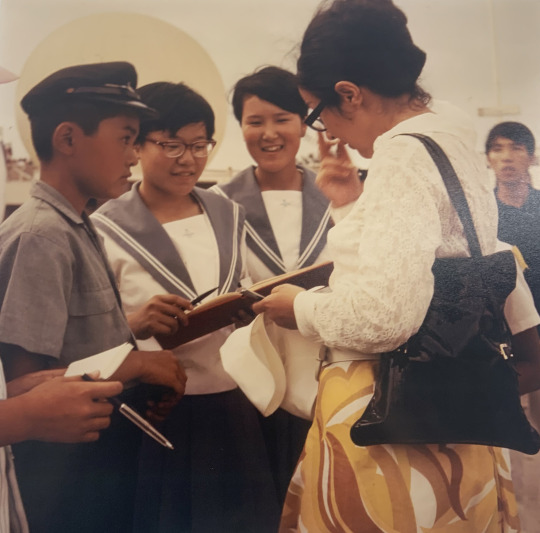

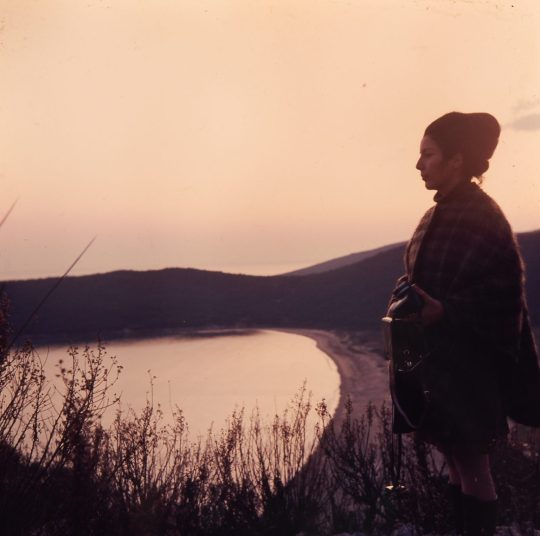
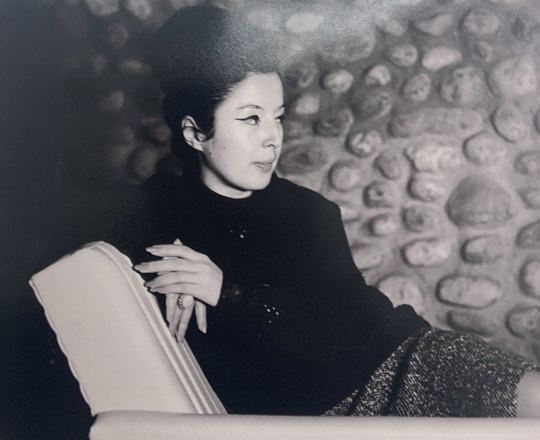




Portrait prints from Radević’s photo archive - shown in the exhibition “Skirting the Center Svetlana Kana Radević, on the Periphery of Postwar Architecture”
“The Gendered Architect - Through hr five-decade career, Radević assembled a photographic dossier with specific emphasis of her own countenance from late adolescence through the 1990s. The trove of portrait photographs - selection from which are shown here - makes palpable the intention with which she construed a pointedly gendering public image, marshalling affectations of femininity to command authority and visibility in a professional context dominated chiefly by men. Examining her self-presentation in architecture’s disciplinary milieu alongside ephemera depicting her figure in personal or domestic realms sheds light on the multivalent nature if her creative practice as an architect, photographer and an activist,” wrote the curators Dijana Vučinić and Anna Kats, who succeed to finally position Svetlana Kana Radević among the most prominent architects in socialist Yugoslavia. Photographs, original drawings, correspondences and other documents stem from her private archive, so far unseen by the public and put at disposal to the exhibition team by Kana’s family. The archival materials reflect her stylistic tendency and her character clearly – merging local materials and international Brutalist tendencies, always with one foot in her hometown of Titograd (today’s Podgorica).
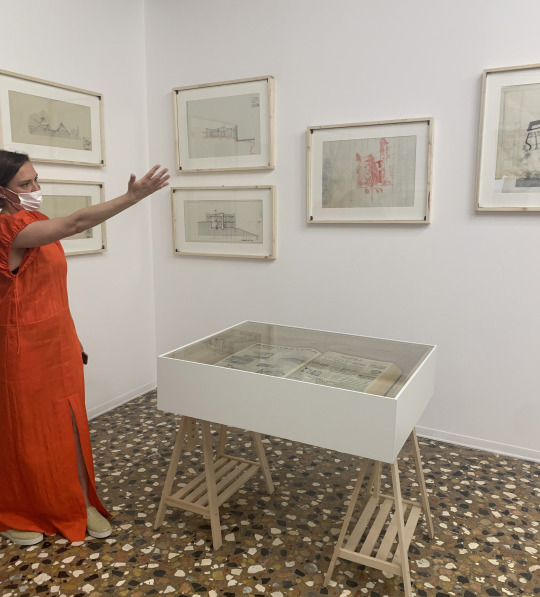
Dijana Vučinić’s presentation at the opening in Venice. | Photo Boštjan Bugarič
Skirting the Center is a highlight in this year’s biennial collateral events because it presents an exceptional and overlooked figure of postwar architecture. The exhibition aims to significantly expand Radević’s representation within the architectural canon by exhibiting the highlights of her built work for the first time the Hotel Podgorica (1964-1967), the most important of Kana’s works, whose design was the winning proposal at the competition. It was also her first important work which placed her at the very top of the architectural scene. The following year it was awarded first the state, and right after the federal Borba award for architecture.


The balconies of Hotel Podgorica faced the river as the building followed its bend. | Photo Personal Archive of Svetlana Kana Radević
Next is the Hotel Zlatibor (1979-1981), which aimed to make the best of socialist lifestyle accessible to both locals and foreign visitors. It is one of the landmarks of the city of Užice in Serbia, named after the nearby mountains, very popular for winter sports. Due to its gray color, the locals derisively called Sivonja (Gray-ner). The Rocket, called by Uzice dwellers, Hotel Zlatibor was completed in 1981 to replace a former, postwar hotel that had been demolished.

Zlatibor hotel betrays the influence of the Metabolist movement grew out of Japan in the 1960s. Indeed, she worked at the Metabolist Kisho Kurokawa’s office for a period. | Photo Svetlana Kana Radević Legacy Collection, Faculty of Architecture, University of Podgorica
Another great architecture is the Monument to Fallen Fighters at Barutana (1980), a sculptural memorial landscape that commemorates local anti-fascist fighters. The monument is dedicated to the warriors fallen in the liberation wars, starting from the First Balkan war to the Second world war. Grouping different motives - a vertical dominant, a radial sequence of elements, separate groups - she managed to create a unique and moved memorial center. Kana said "One of the most difficult design tasks is the monument because it belongs to the domain of non programmatic architecture. The monument is a fixation of certain act for future generations. But this fixation doesn’t mean oblivion. That’s why the monument must be introduced into the cycle of life. I am not for a monument that is experienced in one moment of intense emotions, in pain, in suffering, but rather for a continued experience, for the liberation of the sanctity and dignity, for the feeling that life triumphs over death."
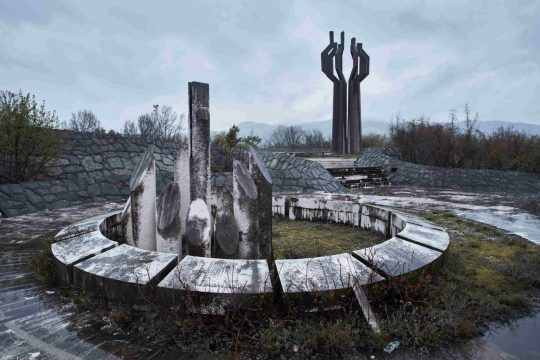
Photo Luka Bošković

Kana in front of her monument in Barutana. | Portrait prints from Radević’s photo archive - shown in the exhibition “Skirting the Center Svetlana Kana Radević, on the Periphery of Postwar Architecture”
--
Skirting the Center - Svetlana Kana Radevic on the Periphery of Postwar Architecture
exhibition at Palazzo Palumbo Fossati San Marco 2597, Venice
from May 22 to November 21, 2021
a collateral event at the XVII Biennale Architettura is organised by the APSS Institute, Strategist, with the support of the Capital City of Podgorica and under the patronage of the President of Montenegro; curated by Dijana Vučinić, Anna Kats.
316 notes
·
View notes
Photo
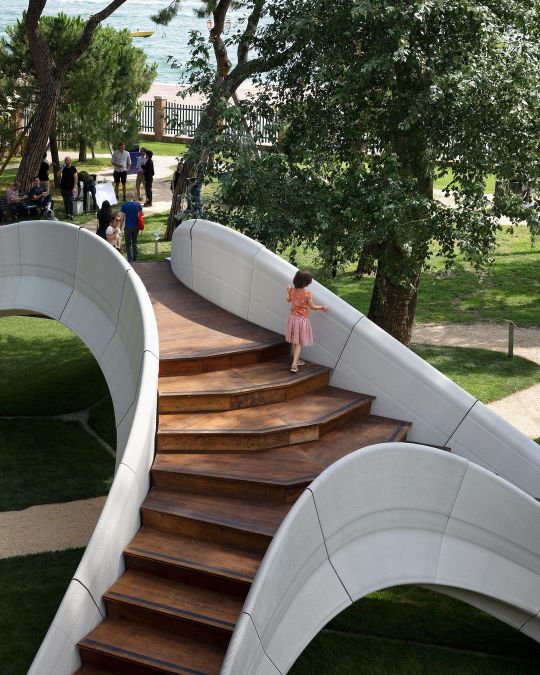
Striatus - a first of its kind 3D concrete printed arched bridge Read more: Link in bio! Striatus: An arched 3D-concrete-printed masonry bridge, is a project by the Block Research Group (BRG) @blockresearchgroup at ETH Zurich @ETHZurich and Zaha Hadid Architects Computation and Design Group (ZHACODE) @ZHCODE, in collaboration with incremental3D (in3D) @incremental3d.eu, made possible by Holcim @holcim.ltd. Striatus is an arched, unreinforced masonry footbridge composed of 3D-printed concrete blocks assembled without mortar. Exhibited at the Giardini della Marinaressa during the Venice Architecture Biennale until November 2021, the 16x12-metre footbridge is the first of its kind, combining traditional techniques of master builders with advanced computational design, engineering and robotic manufacturing technologies. The name “Striatus” reflects its structural logic and fabrication process. Concrete is printed in layers orthogonal to the main structural forces to create a “striated” compression-only funicular structure that requires no reinforcement. Image cover by @studio_naaro. #italy #venice #3dprinting #архитектура www.amazingarchitecture.com ✔ A collection of the best contemporary architecture to inspire you. #design #architecture #amazingarchitecture #architect #arquitectura #luxury #realestate #life #cute #architettura #interiordesign #photooftheday #love #travel #construction #furniture #instagood #fashion #beautiful #archilovers #home #house #amazing #picoftheday #architecturephotography #معماری (at Venice, Italy) https://www.instagram.com/p/CRm4iDABLHM/?utm_medium=tumblr
#italy#venice#3dprinting#архитектура#design#architecture#amazingarchitecture#architect#arquitectura#luxury#realestate#life#cute#architettura#interiordesign#photooftheday#love#travel#construction#furniture#instagood#fashion#beautiful#archilovers#home#house#amazing#picoftheday#architecturephotography#معماری
56 notes
·
View notes
Text
-Venezia-2021-
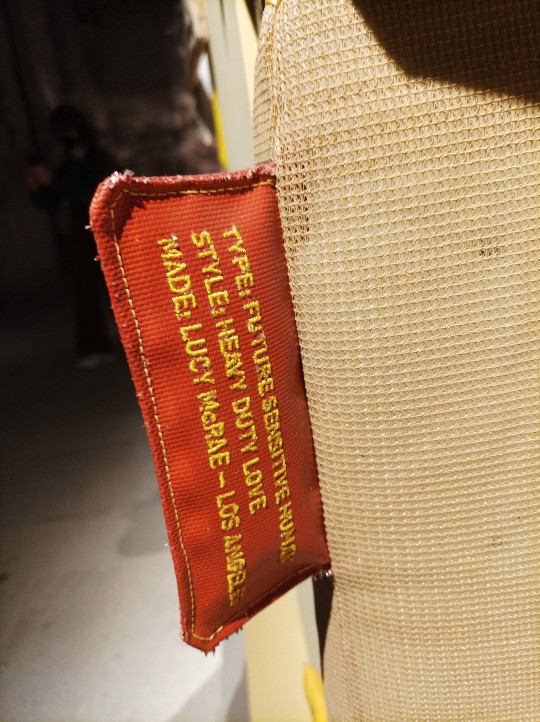

Esposizione artistica alla Biennale di Architettura.
-Frisk-
2 notes
·
View notes
Photo
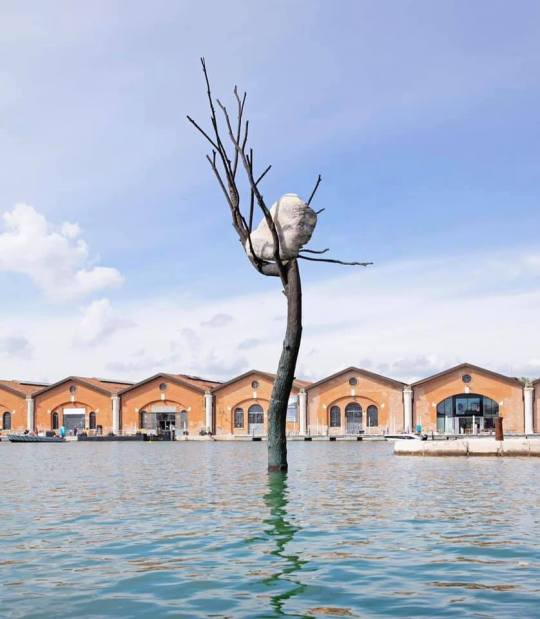
Giuseppe Penone “Idee di pietra - Olmo”, 2008
iInstallazione per la Biennale di Architettura di Venezia, 2021
bronzo, pietra di fiume, acqua
6 notes
·
View notes